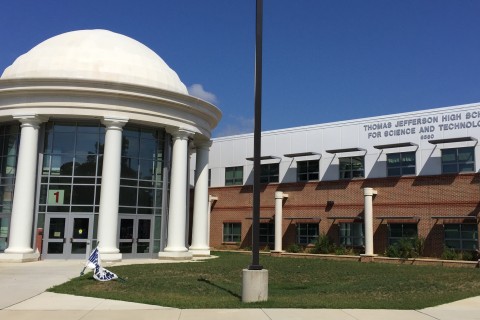
Today, U.S. News published the annual 2019 Best High Schools rankings, which ranked, for the first time, every eligible public high school in the nation. Teaming with North Carolina-based RTI International — a global nonprofit social science research firm — this year’s edition is the largest ranking from U.S. News. Out of more than 23,000 public high schools evaluated, 17,245 are ranked. In the previous edition, U.S. News ranked more than 2,700.
U.S. News revamped the methodology for three reasons:
1. To expand the rankings holistically so all eligible public high schools are ranked, versus previous editions where around 14% of eligible schools were ranked.
2. To make the rankings easier to understand for families seeking to evaluate public high schools in their area. The changes will also make historic comparisons easier going forward.
3. To compare schools using a more comprehensive approach. Schools are ranked on multiple disparate measures of academic quality, versus previous editions where rank order was determined entirely by proportions taking and passing college-level exams.
In addition to being more comprehensive, the revamp of the methodology led to almost all previously ranked schools shifting in the rankings and more than 14,500 high schools that weren’t ranked in 2018 entering the rankings. Below is a more in-depth explanation of why U.S. News made these changes and their impact on the 2019 Best High Schools rankings.
To be included in the evaluation, public high schools needed a 12th-grade enrollment of 15 or greater during the 2016-2017 school year, or otherwise a sufficient enrollment in other high school grades, to be analyzed.
Why Did U.S. News Significantly Change Its Methodology?
U.S. News improved the ranking methodology to measure school performance using a more sophisticated approach. This makes each school’s placement easier to understand and made the rankings as comprehensive as possible. Ultimately, the new system enables visitors to usnews.com as well as educators to more easily determine why any high school received the rank it did.
Additionally, the new 0-100 percentile scoring system in which a school’s rank is linked to its overall score is easier to understand. Each school’s score correlates to its percentile position in the national rankings. For example, a Massachusetts school with a score of 67.0 placed in the 67th percentile of all schools nationally, with 33% of all the schools ranking higher and 67% lower.
As for comprehensiveness, U.S. News wanted to greatly expand the number of schools that are evaluated so that there is broader differentiation among all high schools, not just those that are top performing. In the new rankings, 100% of eligible schools are ranked — compared with around 14% of all high schools in the previous rankings. This enables anyone to look up almost any public high school and see where it ranks.
How Different Are the Revamped 2019 Best High Schools Methodology and Rankings?
Very different. In the previous methodology, rank order was determined solely using the College Readiness Index, based on performance on and participation in Advanced Placement and International Baccalaureate exams. In the revised methodology, six ranking factors are used, each of which are weighted to produce an overall score on which the ranking is based.
These six factors incorporate state assessments and graduation rates, in addition to AP and IB data, that count toward each school’s overall score. Each ranking indicator measures academic excellence differently.
Schools perform better on some indicators than others based on their characteristics and idiosyncrasies with their data. By including multiple quality indicators, schools are rated with an approach that is more diverse and collectively meaningful than if the ranking is based on any single factor. The top-rated schools demonstrate success across multiple areas.
Secondly, the new methodology produces more historically comparable results. Specifically, changes in schools’ ranks in future years should correspond directly with the up or down movements in their data since all eligible schools will continue to be ranked each year. Under the old methodology, highly ranked schools one year sometimes became unranked the next year due to marginal changes in their data that could place them on the unranked side of the ranked or unranked threshold.
Additionally, with the new methodology, all schools that qualify are represented in the rankings. This means that in addition to expanding the main national rankings, U.S. News released new and expanded numerical rankings for all the high schools in each state. This is far more than in the old methodology, in which only slightly more than 14% of each state’s schools were ranked.
For the first time, 1,760 charter and 857 magnet schools are ranked in the Best Charter Schools and Best Magnet Schools national rankings, four times more than were ranked last year.
Lastly, as part of the new methodology, schools are no longer categorized with gold, silver or bronze designations. Instead of medals, U.S. News has numerically ranked the top 75% of the schools nationally and listed the schools in the bottom 25% of the national rankings alphabetically along with the ranking range.
For a more detailed explanation, see the Best High Schools ranking methodology as well as the Best High Schools Technical Appendix.
Why Did Some Schools’ Ranks Change in the 2019 Best High Schools Rankings When Compared With the 2018 Rankings?
In almost all cases, the primary reason for a school’s rise or fall in the 2019 Best High Schools rankings was the revamped ranking methodology.
With so many more schools ranked, more than half of schools ranked in 2018 saw their ranks drop in 2019. This is because the rankings expanded from about 2,700 schools ranked to more than 17,000 ranked.
In many cases, these newly ranked schools in 2019 moved ahead of the schools that were ranked in 2018, therefore pushing the latter to lower ranks. Likewise, some schools that were unranked in 2018 because of their performance on a single ranking factor are now highly ranked based on the totality of their data.
Additionally, with the new methodology determining schools’ rank order based on six ranking factors instead of solely on the College Readiness Index, which was based on performance on and participation in AP and IB exams, there were shifts in schools’ ranks. In other words, some schools that ranked highly in 2018 based solely on their College Readiness Index fell in the rankings because of their lower performance on the three math and reading state assessment tests indicators and the graduation rate indicator, which account for 60% of the rankings.
The reverse was also true — some schools rose significantly in the 2019 rankings since they had very strong performance on the state assessment tests indicators and the graduation rate indicator, despite their relatively lower performance on the College Readiness Index.
Another reason for shifts in the rankings is that a handful of states administered different assessments with varying scoring systems between 2015-2016 and 2016-2017. Even among states administering the same exam both years, some publicly released more fully differentiated data one year versus the next.
How Comparable Are the 2019 Best High Schools Rankings with the Best High Schools Rankings U.S. News Has Published in Previous Years?
The 2019 Best High Schools rankings are not comparable with Best High Schools rankings U.S. News has published in the past. The primary reason is that the new methodology is completely different from the past, so a high school’s performance in the new rankings should not be compared with its past numerical rank or unranked status.
In future years, high schools will be able to use the 2019 Best High Schools rankings as the baseline to compare a school’s performance.
More from U.S. News
See the 2019 Best Public High Schools
How States Compare in the 2019 Best High Schools Rankings
10 Things to Consider When Picking Your Child’s High School
Why U.S. News Revamped the 2019 Best High Schools Rankings originally appeared on usnews.com








